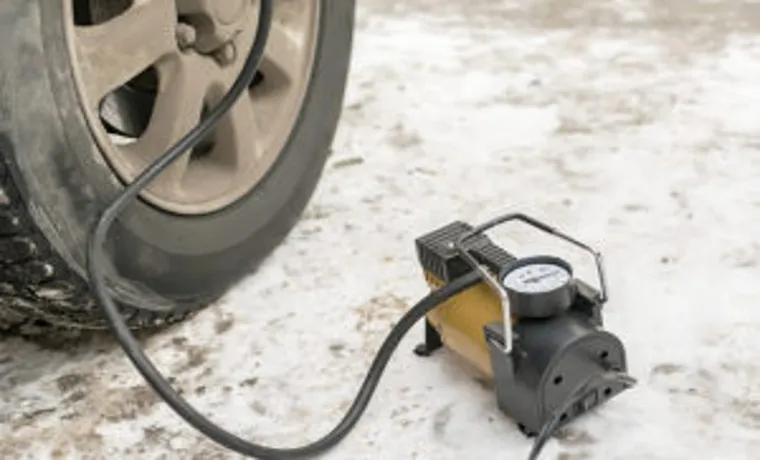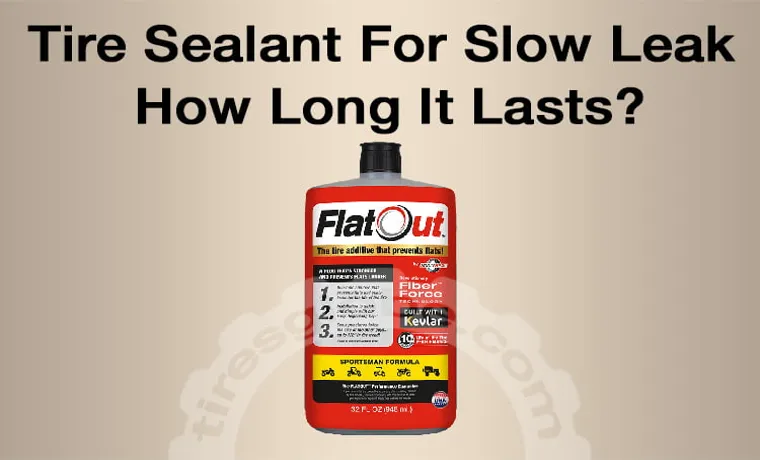Have you ever found yourself in a situation where you’re running late for an important meeting, and the last thing you need is your car tire losing pressure? A slow leak in a tire can be a frustrating situation, leaving you struggling to find a gas station or return to your home or office. Every driver wants to avoid such a predicament and getting a flat tire on the road. However, sometimes a slow leak can go unnoticed, causing more damage to the tire, leading to a potential blowout, and putting the driver’s life at risk.
This is why it’s essential to know how to stop a slow leak in a tire. In this blog, we’ll cover simple steps you can take to fix a slow leak and keep you driving safely on the road.
Table of Contents
Identify the Source of the Leak
If you want to know how to stop a slow leak in a tire, the first thing you need to do is identify the source of the leak. This can be done by inspecting the tire visually for any tears or punctures. You can also use a spray bottle filled with soapy water to locate the leak.
Spray the soapy water onto the tire, and if there is a leak, bubbles will start to form. Once you have identified the source of the leak, you can decide whether it can be repaired or if the tire needs to be replaced. If the leak is caused by a small puncture, it can often be repaired using a tire repair kit and sealant.
However, if the leak is caused by a larger puncture or a tear in the tire, it will need to be replaced. Remember to always check your tire pressure regularly and keep your tires properly inflated to avoid slow leaks in the future.
Inspect the Tire for Damage
When you notice that your tires are constantly losing air pressure, it’s critical to inspect them carefully for potential damage. The first step is to identify the source of the leak. This can be accomplished in a few different ways, but one common method is to use a spray bottle filled with soapy water.
Simply spray the mixture onto the tire’s surface and look for any bubbles that form. These bubbles indicate the location of the leak. Once you have identified the source, you can inspect the tire more closely to determine the extent of the damage.
This could be anything from a small puncture to a larger gash in the rubber. Whatever the cause, it’s important to take action quickly to avoid a blowout down the road. Consider a puncture repair kit or take the tire to a professional for a more thorough inspection.
With the proper attention, you can keep your tires in good condition for longer and enjoy a safer, smoother ride on the road.

Check the Valve Stem
When you notice a leak in your tire, identifying the source can be tricky. One common culprit is a faulty valve stem. This small but important part of the tire can wear out over time and begin to leak air.
Checking the valve stem is a quick and easy process. Start by inspecting the stem for cracks or damage. If it looks worn out, it may need to be replaced.
Then, use a tire pressure gauge to check the pressure of the tire. If it’s low, try adding air and see if it holds. If the pressure drops quickly, it’s likely that the valve stem is the source of the leak.
In this case, a replacement valve stem is an easy and affordable fix that can save you from more costly repairs down the road. Don’t ignore a leaking tire – take the time to identify the source and address it promptly to stay safe on the road.
Check Tire Pressure
If you’re experiencing a slow leak in your tire, one of the first things you should do is check the tire pressure. A tire that is underinflated can cause a leak or even a blowout, so it’s important to make sure your tires are properly inflated. You’ll want to consult your vehicle’s owner manual to find out what the recommended tire pressure is for your vehicle.
Once you have that information, you can use a tire pressure gauge to check the pressure of each tire. If you find that your tire is low, inflate it to the recommended pressure. It’s also important to check the tire for any punctures or damage, as these can cause slow leaks as well.
If you notice any damage, take your vehicle to a mechanic to have the tire repaired or replaced. By being proactive and keeping an eye on your tire pressure, you can prevent a slow leak from turning into a major problem.
Use a Tire Pressure Gauge
When was the last time you checked your tire pressure? It’s a simple task that can be easily overlooked, but maintaining proper tire pressure is essential for both your safety and the longevity of your tires. Using a tire pressure gauge is the most accurate way to check your tires’ pressure as it measures the pounds per square inch (PSI) of air in each tire. Underinflated tires can increase fuel consumption, reduce tire lifespan, and compromise handling.
Meanwhile, overinflated tires can cause uneven wear and reduced contact with the road, leading to decreased traction. By regularly checking your tire pressure with a gauge, you can ensure that your tires are properly inflated, keeping you safer on the road and saving you money in the long run.
Inflate the Tire to the Recommended Pressure
When it comes to maintaining your vehicle, checking tire pressure is a crucial step. Underinflated tires can lead to poor handling, reduced fuel efficiency, and increased wear and tear. Overinflated tires, on the other hand, can make your car ride more rigidly and even be more prone to bursting.
So, it’s important to inflate your tire to the recommended pressure. But, how do you know what that is? Firstly, check your owner’s manual or the sticker on the inside of the driver’s door for the recommended psi. Once you have that number, use a pressure gauge to measure the current pressure in your tire.
If it’s below the recommendation, inflate it to the correct psi. Be sure not to overinflate, as that can be just as dangerous. When it comes to tire pressure, a little attention goes a long way.
So, make it a point to check your tires regularly so you can enjoy a safe and smooth ride.
Check for Leaks Using Soap and Water
If you want to avoid unexpected tire problems, you need to check your tire pressure regularly. One of the most efficient ways to do this is by using a pressure gauge. Once you have confirmed that the pressure is at the right level, you can take the extra step of checking for leaks.
One way to do this is by using soap and water. Simply mix water and liquid soap in a bowl, and apply a small amount of the solution to the valve and around the rim of each tire. If you see bubbles start to form, this indicates that there is a leak in your tire.
A leaky tire can cause decreased performance, reduced gas mileage, and possible blowouts. Therefore, make sure you inspect your tires for leaks regularly and fix any issues immediately. This will help ensure your car runs smoothly and safely, no matter where you’re headed.
Sealing the Leak
Having a slow tire leak can be frustrating and dangerous if not addressed promptly. One way to stop the leak is by using a tire sealant. A tire sealant works by sealing small punctures, usually up to ¼ inch in diameter, without having to remove the tire or even locate the exact location of the leak.
It’s a quick and easy solution that can be done in minutes, and it’s great for emergency situations. However, it’s important to note that tire sealants are only a temporary fix and should not be relied upon for extended periods. It’s still important to get your tire properly fixed or replaced as soon as possible.
Remember, safety always comes first when it comes to maintaining your vehicle’s tires.
Use a Tire Sealant
If you’ve discovered a leak in your tire, don’t panic. One of the easiest ways to fix it is by using a tire sealant. A tire sealant is a liquid that can be poured directly into the tire and will coat the inside of the tire, sealing any holes or leaks.
It’s a quick and easy way to fix a leak without having to remove the tire or take it to a mechanic. The best part about using a tire sealant is that it’s a temporary fix that can give you enough time to get to a safer location before figuring out a more permanent solution. Some of the best tire sealants can seal punctures up to 3/8 of an inch in diameter.
It’s important to note that tire sealants are not a permanent fix and the tire will eventually need to be repaired or replaced. But in the meantime, a tire sealant can give you peace of mind and keep you on the road. So, if you find yourself with a leaky tire, consider using a tire sealant to temporarily fix the problem.
Patch the Tire
When you find a leak in your tire, the best thing to do is patch it up quickly. Ignoring it can lead to a blowout or more extensive damage to the tire. Patching a tire is a simple process that can be done at home or by a professional.
First, locate the puncture or leak in the tire and remove any debris from the area. Next, use a tire repair kit to seal the leak. These kits typically include a patch and adhesive.
Be sure to follow the instructions carefully to ensure a tight seal. It’s important to note that patching a tire is a temporary fix and the tire should be replaced as soon as possible. Driving on a patched tire for an extended period can be dangerous and may cause further damage.
Taking care of your tires will help ensure your safety on the road.
Preventing Future Leaks
If you want to prevent future leaks in your car tire, the first step is to check your tire pressure regularly. A low tire pressure can increase the chances of a slow leak, as can driving on rough roads or over objects such as nails or glass. You should also avoid overloading your vehicle, as this places additional stress on your tires and increases the risk of a blowout.
Additionally, it’s important to have your tires balanced and rotated regularly to ensure even wear and prevent leaks. Finally, consider investing in high-quality tires made from durable materials that are less likely to develop leaks over time. By following these steps, you can help keep your car safe and avoid the frustration of dealing with frequent tire leaks.
If you do notice a slow leak, it’s important to have it addressed as soon as possible to prevent further damage and ensure your safety on the road.
Maintain Proper Tire Pressure
Proper tire pressure is important in preventing future leaks in your tires. Monitoring your tire pressure regularly can reduce the risk of punctures and tears caused by underinflation. When your tire is underinflated, it puts more stress on the tire than it is designed to handle, which can cause it to weaken over time and lead to leaks.
Overinflation can also cause tire damage, as it puts more pressure on the tire’s inner lining. Regularly checking your tire pressure ensures that your tires are properly inflated, reducing the risk of leaks and prolonging the life of your tires. Remember, maintaining proper tire pressure is just as important as any other routine maintenance task, and can save you time and money in the long run.
Avoid Driving Over Obstacles
When it comes to preventing future leaks in your car, there are several things you can do to keep your vehicle in tip-top shape. One of the most important things you can do is to avoid driving over obstacles, such as speed bumps, curbs, or potholes. Not only can these obstacles cause damage to your car’s suspension and alignment, but they can also damage your car’s undercarriage and potentially cause leaks.
When you drive over these obstacles, they can cause your car to bounce and jostle, which can put additional stress on weak seals or gaskets and cause them to crack or break. By avoiding these obstacles whenever possible, you can keep your car running smoothly and prevent leaks from occurring in the future. So, be sure to take care when driving and avoid any unnecessary bumps or obstacles on the road.
Your car (and your wallet) will thank you!
Replace Worn Tires on Time
Replacing your worn tires at the appropriate time not only improves the overall safety of your vehicle, but can also prevent future leaks. Tires that are old or worn down may experience punctures or cracks that lead to air leaks. As air continues to escape from the tires, this can cause the tires to wear down at a faster rate and even lead to a dangerous blowout.
By replacing your tires on time, you can avoid these potential issues and save yourself from the headache and cost of unexpected repairs. It’s important to do a regular visual inspection of your tires to check for any signs of wear or damage, and to replace them as needed. By staying on top of your tire maintenance, you can enjoy a safer and more efficient ride on the road.
So, don’t wait until it’s too late – prioritize your tire health and stay safe on the road.
Conclusion
In conclusion, stopping a slow leak in your tire requires some quick thinking and resourcefulness. First, locate the leak by using soapy water or a tire pressure gauge. Then, remove any foreign objects from the tire and patch the hole with a tire repair kit, or replace the tire entirely if necessary.
Remember to inflate the tire to the correct pressure and monitor it closely for any further signs of leakage. With these simple steps, you’ll be back on the road in no time! Just remember, a watched tire never leaks… well, that may not be entirely true, but it’s always better to be safe than sorry!”
FAQs
What are the signs of a slow leak in a tire?
The signs of a slow tire leak include a steadily decreasing tire pressure, a visible puncture or damage to the tire, and a feeling of instability or vibration while driving.
How can I locate a slow leak in my tire?
To locate a slow leak in your tire, spray soapy water onto the tire while it is inflated and look for bubbles. Also, listen for a hissing sound which indicates the location of the leak.
Can a slow tire leak be fixed with a sealant or tire repair kit?
Yes, a slow tire leak can often be temporarily fixed with a tire sealant or repair kit. However, it is important to have the tire professionally repaired or replaced as soon as possible.
How can I prevent a slow tire leak in the future?
You can prevent a slow tire leak by regularly checking your tire pressure, avoiding driving on rough or rocky terrain, and avoiding hitting curbs or other objects that may cause tire damage.
What is the proper way to inflate a tire to prevent slow leaks?
In order to prevent slow tire leaks, it is important to inflate your tires to the correct pressure level as stated in your vehicle’s owner manual. Use a tire pressure gauge to ensure the tire pressure level is accurate.
How long can I drive on a slow leaking tire before getting it fixed?
It is not recommended to continue driving on a slow leaking tire as it can cause further damage to the tire and create a safety hazard. Get it fixed as soon as possible or use a temporary fix until you can get it fixed.
Can a slow tire leak cause damage to my vehicle?
Yes, driving on a tire with a slow leak can cause uneven tire wear, affect the handling of the vehicle, and ultimately lead to a blowout or other safety issues. It is important to get the tire fixed as soon as possible.



